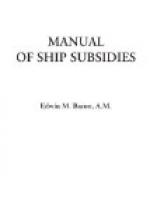* * * * *
Of the British colonies, Canada grants mail and steamship subsidies, and fisheries bounties. In 1909-10 the Dominion’s expenditures in mail and steamship subsidies amounted to a total equivalent to $1,736,372. The amount appropriated for 1910-11 increased to $2,054,200; while the estimates for 1911-12 reached a total of $2,006,206. In these estimates the larger items were: for service between Canada and Great Britain; Australia by the Pacific; Canadian Atlantic ports and Australia and New Zealand; South Africa; Mexico by the Atlantic, and by the Pacific; West Indies and South America; China and Japan; Canada and France.[AY] The home Government pays the same amount as Canada toward maintaining the China and Japan, and British West Indies services.[AZ] The fisheries bounties amounted to one hundred and sixty thousand dollars in 1909.[BA]
* * * * *
The grand total of subsidies and subventions paid by Great Britain and all her colonies in 1911 approximate ten million dollars annually. The subsidies and mail pay of the Imperial Government amounted, in round numbers, to four million dollars, of which, in 1910, the Cunard Company received seven hundred and twenty-nine thousand dollars.[BB] Besides the Admiralty subventions, retainer bounties are paid to merchant seamen and fishermen of the Royal Naval Reserve.
Since the establishment of steam in regular ocean navigation, and the substitution of iron for wooden ships, England has maintained her leadership among the maritime nations. The total tonnage of the United Kingdom and her colonies, steam and sailing ships, in 1910-11, stood at 19,012,294 tons.[BC] nearly four fold that of any other nation.
FOOTNOTES:
[Footnote A: Royal Meeker, “History of Ship Subsidies.”]
[Footnote B: John E. Green, “Short History of the English People.”]
[Footnote C: W.H. Lindsay, “History of Merchant Shipping.”]
[Footnote D: Lindsay.]
[Footnote E: David A. Wells, “Our Merchant Marine,” p. 96.]
[Footnote F: John Lewis Ricardo, “The Anatomy of the Navigation Laws,” p. 111.]
[Footnote G: Lindsay, vol. III.]
[Footnote H: Lindsay, “Our Navigation Laws”; also his History.]
[Footnote I: Ricardo; also Lindsay in other words.]
[Footnote J: Meaning the waters between Great Britain and the continent.]




